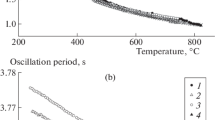Abstract
The temperature dependences of the dynamic viscosity of the InBi100 – xPbx (where x = 19, 40, 60, 80, and 100 at %) melts are studied in the range from the liquidus temperature to 1200 K by the oscillating crucible method. The temperature dependences of the viscosities of melts of these compositions are well described by the Arrhenius equation. The viscosity of the InBi–Pb melts at a constant temperature has small negative deviations from the ideal mixture viscosity. The activation energy of a viscous flow has negative deviations from additive values with a minimum near 20 at % Pb. The concentration dependences of the viscosities of the melts are calculated using the well-known equations based on the thermodynamic properties. The obtained results are compared with the experimental data.



Similar content being viewed by others
REFERENCES
V. G. Il’ves, V. V. Filippov, and S. P. Yatsenko, “Phase equilibria in the In–Bi–Pb system,” Metally, No. 5, 166–168 (1992).
D. Boa and I. Ansara, “Thermodynamic assessment of the ternary system Bi–In–Pb,” Thermochim. Acta 314, 79–86 (1998).
D. Živkovic, D. Manasijevic, and Ž. Živkovic, “Thermodynamic and phase diagram investigation of Pb–BiIn section in Pb–Bi–In ternary system,” Thermochim. Acta 417, 119–125 (2004).
V. V. Filippov, S. A. Uporov, V. A. Bykov, K. Yu. Shunyaev, and B. R. Gelchinsky, “An automated setup for measuring the viscosity of metal melts,” Instrum. Exp. Tech. 59, 305–311 (2016).
H. Walsdorfer, I. Apshofen, and B. Predel, “Viskosity and specific electrical resistance of liquid alloys of the In–Sn and In–Bi systems,” Z. Metallkd. 79 (8), 503–512 (1988).
E. A. Moelwyn-Hughes, Physical Chemistry (Pergamon, London, 1961).
L. Ya. Kozlov, L. M. Romanov, and N. N. Pewtrov, “Prediction of the viscosity of multicomponent metallic melts,” Izv. Vysshikh Uchebn. Zaved., Ser. Cher. Met., No. 3, 7–11 (1983).
W. Gasior, “Viscosity modeling of binary alloys: comparative studies,” Calphad. 44, 119–128 (2014).
Funding
This work was supported by the Russian Foundation for Basic Research, project no. 19-03-00770-a.
Author information
Authors and Affiliations
Corresponding author
Additional information
Translated by Yu. Ryzhkov
Rights and permissions
About this article
Cite this article
Filippov, V.V., Shunyaev, K.Y. Viscosity of the InBi–Pb Melts. Russ. Metall. 2021, 192–195 (2021). https://doi.org/10.1134/S0036029521020075
Received:
Revised:
Accepted:
Published:
Issue Date:
DOI: https://doi.org/10.1134/S0036029521020075




